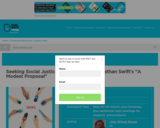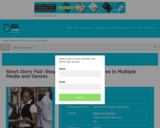
This workbook contains checklists, text organizers, writing frames and more for: short stories and informational texts. These work with any text.
- Subject:
- English Language Arts
- Material Type:
- Lesson
- Unit of Study
- Author:
- PACT
- Date Added:
- 10/15/2021

This workbook contains checklists, text organizers, writing frames and more for: short stories and informational texts. These work with any text.

At Crick Software we believe that too many children struggle with their learning due to their literacy difficulties. We created our products to overcome those difficulties, and we made them accessible for all. With the right tools, every child can achieve their potential. Our products support students with dyslexia, learning difficulties, autism, physical disabilities, and other special educational needs.

Students will have a whale of a good time in this lesson in which they use fiction and nonfiction texts to write a letter to an online scientist.

After examining recipes written based on students' favorite fairy tales, students research a recipe related to their favorite story, book, or fairy tale and include it in a classroom recipe book.

High school students are taught how to use resumes and cover letters to highlight their skills and make them stand out, whether applying to college or for a job.

The Riddle Interactive outlines the characteristics of riddle poems and provides direct instruction on the prewriting and drafting process for writing original riddle poems.

In this lesson, students use a scaffold to help them compile information to write a solid research paper.

Each small group of students researches one aspect of the same big topic, such as the Gold Rush, and teaches what they have learned to the rest of the class.

Jonathan Swift's 1729 pamphlet "A Modest Proposal" is a model for satirizing social problems. In this lesson, students complete multiple readings of Swiftĺĺs essay: a guided reading with the teacher, a collaborative reading with a peer, and an independent reading. The online Notetaker tool helps students restate key ideas from Swift's essay as they read and elaborate upon these ideas postreading. After independent reading, pairs of students develop a mock television newscast or editorial script, like those found on Saturday Night Live's "Weekend Update," The Daily Show with Jon Stewart, or The Colbert Report, including appropriate visual images in PowerPoint.

In this activity, students read short stories and create presentations in multiple media to share in a Short Story Fair. At the fair, students explore and respond to the displays.

The Stapleless Book can be used for taking notes while reading, making picture books, collecting facts, or creating vocabulary booklets . . . the possibilities are endless!

Students analyze personal homepages, as well as a character in a book they have read, and then create a homepage for the character.

The Story Map interactive is designed to assist students in prewriting and postreading activities by focusing on the key elements of character, setting, conflict, and resolution.

People make the past come alive as students research and then share stories about famous Americans who promoted democratic ideals.

Students are introduced to the genre of multimedia presentations through a review and analysis of online presentations. They then apply what they have learned to create their own multimedia presentations.

Stories and poems that have a familiar structure can create a supportive context for learning about the writing process, building students' background knowledge, and scaffolding their creation of original stories. In this lesson for students in second or late first grade, teachers help students explore the concepts of beginning, middle, and ending by reading a variety of stories and charting the events on storyboards. As they retell the stories, students are encouraged to make use of sequencing words (first, so, then, next, after that, finally). A read-aloud of Once Upon a Golden Apple by Jean Little and Maggie De Vries introduces a discussion of the choices made by an author in constructing a plot. Starting with prewriting questions and a storyboard, students construct original stories, progressing from shared writing to guided writing; independent writing is also encouraged.

One of the most difficult aspects of writing is keeping audience in mind throughout the writing process. Developing lessons that support this strategy for writing is essential in the elementary classroom. This lesson supports first-grade students in learning about audience. Through interactive writing, students work together to create a genuine invitation letter for a group of their peers. In addition to the interactive writing experience, students work independently to create invitation letters for their families. Extension activities include conducting additional interactive writing experiences, reading books with samples of letters, and creating invitations at a learning center.

Writers and film buffs alike will sharpen their skills in this multimedia unit as they work together to author and design a digital video.

Students tell their life stories in this lesson about autobiographies based on family photographs.

Students use both analytical and creative skills to adapt passages from a novel with significant internal dialogue and conflict, such as Toni Morrison's "Beloved", into a ten-minute play.